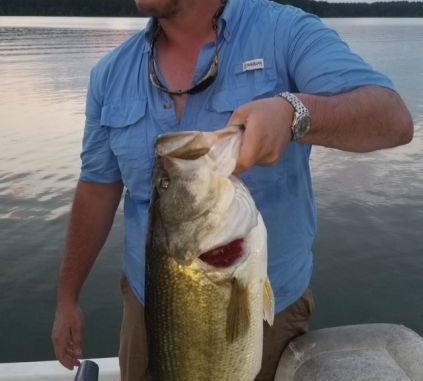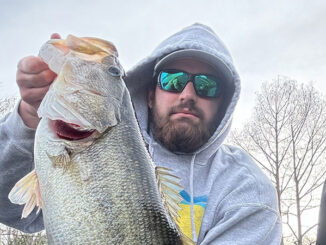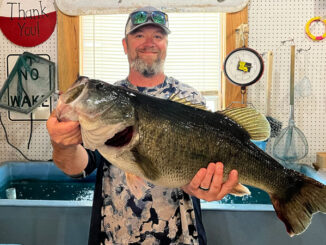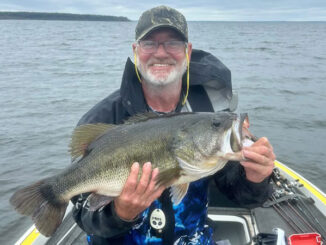
Like other bass fishermen up here in late summer and early fall, I was getting wrapped up in the “grass thing” — punchin’, droppin’, flippin’, whatever you want to call it — and trying like heck to get bit on topwater.
That green stuff, especially in Housen Bay, which has the prettiest, greenest vegetation it ever has had, looks like it’s begging to give up bass on topwaters — especially on those overcast days. But that hasn’t been the case for me, although fishing the grass has been rewarding on bright, sunny days (go figure) with calm winds — and I did catch a big one weighing almost 9 pounds in October.
But I struggled to get the topwater or plastic frog bite. It was so frustrating. Why didn’t the bass come up in the grass and smack the tar out of a Chug Bug, Pop-R, Spittin’ Image or plastic frog? For whatever reason, the bass just didn’t come up for it in the grass. Last month I came to the conclusion there were other kinds of water that pattern should be effective in — areas without a blade of grass, but with plenty of wood and other structure.
You can’t tell me those main feeder creeks that once had grass — but don’t now — don’t have bass in them. The answer is they’re still living in those same waters, so I’m fixing to make a few changes and pop into a few places with no vegetation and use buzzbaits, plastic frogs, jerkbaits and Rat-L-Traps just like in the spring months when bass move shallow, basically into 10-foot depths and less.
That the pattern should be effective in late November and December (weather and water conditions permitting) was verified in mid-October by a young bass fisherman who spent a week up here before a bass club tournament. Jacob Shoopman of New Iberia stayed in a feeder creek on the Louisiana side and caught dozens of bass, mostly on a chrome/blue popper, that he worked fast — kind of walking the dog. He pulled out five 4- to 5 ½-pound bass during that stay, including two hawgs the first day of the tournament. His dad, Louisiana Sportsman outdoors writer Don Shoopman, caught two nice ones off docks, one about 7:15 a.m. his first day on the water with Jacob on a Delta Lures Thunder Jig, and one on a buzzbait at 1:10 p.m. on a bluebird afternoon his second day.
They said those fish were in 1- to 8- foot depths. Ben Suit won the tournament while fishing with his dad Kevin, using mostly buzzbaits in a grassless creek on the Texas side in 1- to 3-foot depths.
I’m sold. The grass bite still will be going on (as long as the grass holds up and the baitfish are there) this time of year, but I’ll spend time basically bank fishing like we do in the spring. After all, with significant cold fronts already blowing through in October, the water temperatures should be ideal — in the 60s and 70s. Bass will get shallower and shallower, and so will the bream and shad.
I’d motor halfway into a creek, stop and start targeting secondary points all the way to the back. Pick out something different.
So between the grass and the banks, bassers venturing out on this great border lake should be able to get bit consistently in December. The game-changer will come when the Arctic cold fronts hit and chill the water into the 50s — but that’s another story.
The lake level in early November was at 167.57, with no generation at the dam. Unless the region gets some unseasonably heavy rainfall, it should stay at that stage throughout the winter.
It has been a non-typical year for bassin’ at Toledo Bend. The fish this year stayed deep — 22 to 27 feet, more than I’ve ever experienced.
But targeting grass in 8- to 11-foot depths should produce until the conditions change. I’d use red bug or plum creature baits and Senkos, black/blue jig-n-pig combinations or black/blue/silver Stanley Swim Jigs. Fish the deepest grass in that depth range you can find and concentrate on the scattered clumps, not the matted stuff. That’s what’s working best for me now.
That kind of fishing has been fair to good when the sun’s shining and the wind isn’t blowing. When it’s howling 20- to 30-mph, it’s a struggle with the boat and to get them to bite. But sunshine puts them tighter on the grass. You’d think with dark cloud cover they’d be going gangbusters in and around the grass, but that just hasn’t been the case.
Speaking of vegetation, it’s returning in several places up north, most notably at 1215, Wright’s Landing and Bison. It isn’t deep grass but it’s in 6- to 8-foot depths and looking good — very promising for the future.
Crappie fishermen had another great year on the lake, but crappie fishing should be fair at best in December. Maybe, just maybe, the water temperature will plunge into the 40s on some of those frigid nights in January and February, and the crappie will gang up along the river channel like they used to do. It’d be great to see the Chicken Coop get red-hot again on the Texas side of Toledo Bend.
If you want to catch bass in December, when success can be very good (weather and water conditions permitting,) I’ve been guiding on this lake most of my life and you’re welcome in my boat. Go ahead and give me a call at (936) 404-2688.


